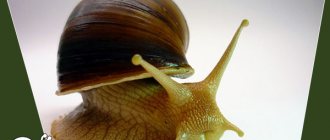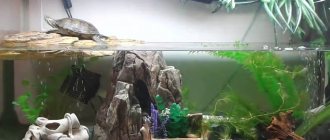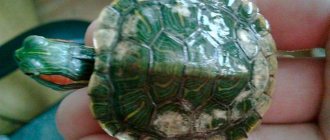Red-eared turtles often hibernate during the winter. Thus, they climb into the shell and sleep. Breeders sometimes perceive this phenomenon as the death of a pet, because it is practically impossible to determine whether the reptile is breathing due to the protective shell. In order not to bury your pet alive, you should familiarize yourself with the possible signs of death, as well as the reasons why turtles may die.
Of course, if the pet remains in hibernation when the weather warms up, then breeders should be wary. But if the room is cold enough, then the reptile will not wake up. In this regard, it is necessary to create the correct conditions, warm the terrarium and add warm water. If the animal remains in its shell, and there are no other signs of life, then mortality should be determined by other measures.
How to understand that a pet has died
If it happens that the reptile shows no signs of life, then you need to know how to detect death.
There are several ways to do this, but it should be noted that all of them will be stressful for a living creature and can provoke diseases. Below are all the possible signs of how to tell if your pet is alive or dead:
If the reptile is kept in a cold environment in its home, hibernation has begun, the pet was transported in a container without additional heating, then the animal should initially be heated. To do this, just heat or add warm water. It is important that the reptile does not choke or drown. After this, it can be placed next to a heating source, in other words, under a lamp.
If, after the operations performed, there are no signs of life and activity, then the pet may be dead. But it is better to use additional verification measures. You should check your pet's reflexes. The cornea of the eye and pain thresholds manifest themselves perfectly.
To test reflexes using pain, you need to take a needle and prick the reptile’s paw a little. If there are reflexes, then she will simply pull her paw and begin to move it. To test reflexes, stimuli should be generated on the cornea. Then the centuries will begin to open and close. To do this, you need to carefully touch the cornea with a blunt metal object. If the eye shows no signs, then this means that the turtle has died. You can also check using an oral examination.
To do this, you should open it and look at the shade of the mucous membrane. In a living reptile it should be pink, perhaps pale or bright, it all depends on the condition of the reptile. A dead individual will have a blue color with gray tones. You can also look at your breathing movements by examining your mouth. This can be seen in the larynx, which must open and close. If the larynx is closed and does not move or is constantly open, then most likely this is a sign of death.
Once a turtle has died, its mouth will remain open, even if the owner no longer examines it. You can determine whether a turtle is alive using its heartbeat. True, such an inspection cannot be performed at home. To do this, you need to call or go to the veterinarian.
Sometimes sunken eyes are also a sign of death. But it is better not to use this method for a single check, because it is not accurate. And the last thing is the appearance of a foul odor from the pet. It appears when the flesh has already begun to decompose.
Death of turtles, signs and ascertainment of death
Like any other creature on the planet, a turtle can die. This happens due to illness, improper maintenance, old age. Death from old age is extremely rare, especially when maintaining a home. Typically, by the time a turtle reaches adulthood, a number of diseases accumulate and make themselves felt. To prevent premature death, you need to carefully monitor the condition of your pet, create all the necessary conditions for keeping and feeding it that are close to natural. And in case of malaise, apathy, lack of appetite or other alarming signs, contact a veterinarian-herpetologist. At the initial stage of the disease, the percentage of successful treatment is higher.
But often in an animal like a turtle it is difficult to determine whether it is really dead or in a state of hibernation or coma. In doubtful cases, it is better to leave the turtle for a day and then identify it again (usually after this period the picture becomes clearer).
To do this, we will describe some criteria by which you can make a conclusion about the condition of the turtle.
- If the turtle was kept on a cold floor, terrarium, or was in a state of hibernation, transported in a container without heating, then first such an animal must be warmed by placing it in warm water (but so that the turtle does not drown or choke), and then under a heating lamp . If no activity occurs after this, then evaluate the following points.
- Determine the presence of reflexes. Particularly indicative are the corneal reflex and the pain reflex. To determine the pain reflex, you can prick the turtle's paw with a needle; if there is pain, the turtle withdraws its paw and moves it. The corneal reflex is expressed in the closing of the eyelid in response to irritation of the cornea. That is, it is necessary to touch the cornea and determine whether the turtle reacts to this by closing the lower eyelid.
- The next thing you can do is open the turtle's mouth and evaluate the color of the oral mucosa. In a living turtle it is pink (can be pale or bright pink depending on the condition), in a dead turtle it is bluish-gray (cyanotic).
- When checking the color of the mucous membranes in the mouth, the presence of respiratory movements can be assessed by the opening and closing of the laryngeal slit at the base of the tongue. The laryngeal fissure opens during inhalation and exhalation, the rest of the time it is closed. If there is no movement of the laryngeal slit, or it is constantly open, then most likely the turtle is no longer breathing.
- If after you open your mouth, it remains in this open state, this already indicates that the turtle has rigor mortis.
- Unfortunately, it is impossible to determine the heartbeat at home without special medical equipment.
- Sunken eyes can be an indirect sign of death. But, of course, you shouldn’t use it as the only sign.
- At the stage of cadaveric decomposition, a characteristic unpleasant odor appears from the animal.
Article on the topic: Soft shell in a turtle: causes and treatment
If you have any questions about the care or your pet requires veterinary care, please call 8 (917) 526-49-72.
Herpetologist Anastasia Agafonova
Stress
When you just bought a reptile, it is not surprising that it refuses food. It can take her a day to get used to her new place of residence. The animal is stressed, so she refuses to eat. As soon as the pet gets used to the new conditions, it will begin to take food.
At first, you shouldn’t stand near the terrarium for a long time, much less knock on it. Until the animal gets used to it, you should not try to pick it up, so as not to unnerve your pet again.
Moreover, you should not handle baby turtles; babies are very timid and this can become stressful for them; as a result, they stop eating and may even get sick.
Solution
The longer a red-eared turtle goes without eating, the more dangerous its condition becomes. Contact a specialist. If this is not possible, for example, there are no veterinarians in the city who specialize in reptiles, start by checking compliance with the conditions of detention.
- A complete diet. Turtles refuse food they don't like. Replace it, but remember to balance your diet.
- Check if the turtle has enough space in the terrarium.
- Clean all surfaces of the turtle house.
- Remove small rocks and decorations that the turtle might swallow.
- Adjust the temperature.
- Aquatic breeds need a place to rest outside of the water. Check if there is enough space for all the inhabitants of the terrarium.
- Remember, the red-eared turtle at home is very demanding on the quality and purity of water. Install high-quality filters and change the water at least once a week.
- Limit the animal's walks outside the terrarium.
- Make sure that no food remains submerged in the water. It will pollute the water.
- Do not self-treat your pet. Without experience, identifying and treating the disease is not easy.
Don’t skimp on purchasing the necessary equipment; treating a turtle can become much more expensive and troublesome. Most of the turtles in our homes are Central Asian (land) and red-eared (aquatic), less common are European swamp turtles (aquatic) and Far Eastern Chinese trionics (aquatic). Having decided on the species, take a close look at the turtle.
Examine the turtle's eyes - they should not be constantly closed, swollen, watery, or sunken. A healthy turtle does not drag itself with difficulty along the surface, but steps on all four paws, stretches its neck, exploring the surroundings. The turtle should not make squeaks, wheezes, whistles, or clicks (do not confuse all this with hissing when they are trying to scare you!). The shell of a healthy turtle is quite smooth, without bumps, humps or depressions, evenly convex on top (this is the carapace) and smooth below (this is the plastron).
If the turtle is dead, then it will not move them. She didn't eat for 2 days and they brought her to the veterinarian. Like any other animal, a turtle can get sick. My name is Zina. I am a red-eared turtle. It is advisable to check how turtles sleep sometimes and weigh them. Watching them, you understand that they are not so emotionless and stupid.
What factors can cause eye problems?
A healthy turtle usually sleeps very little, but it arrives in excellent condition both day and night. It is advisable to observe the animal throughout the day. If the reptile constantly sleeps and arrives in a lethargic state, then this may indicate the beginning of the development of a certain illness. But the eyes can be clear, shiny, and wide open.
If suspicious symptoms are detected, you can immediately adjust the turtle’s living conditions. Thus, health problems in an amphibian animal can be caused by the following factors:
- reduced water temperature;
- insufficient use of an ultraviolet lamp or its complete absence;
- very cold water;
- unbalanced diet;
- poor water filtration, irregular bottom cleaning.
If all these factors are corrected, but the turtle still does not open its eyes for 6 hours, this will mean that it has a pathological process. In this case, it is necessary to identify exactly what disease has affected the turtle.
But in any case, you need to stock up on the following resources:
- Prepare a medium container (small aquarium). It will be needed for quarantine;
- It is advisable to buy pharmaceutical chamomile;
- Methylene blue;
- Cotton swabs or swabs.
Of course, other medications may be required, but this will depend on what ailment has affected the pet. For this reason, it is worth knowing the main eye diseases and what to do if you have them.
In any case, a living turtle does not emit any odors.
After 2-3 days, the dead turtle will smell of corpse decomposition. In general, a turtle’s poor condition usually does not begin immediately; it does not die suddenly, but gradually becomes ill with something. Therefore, the owner’s task is to correctly and promptly recognize this deterioration of the condition and take the turtle to the veterinarian in time to begin treatment. 40% (those turtles that survive to be sold often find themselves in such conditions that “it would be better if they died as children” than to suffer in dirty aquariums or on the floor under a radiator).4.
Moreover, by the time of death, turtles often have a whole complex of diseases - from vitamin deficiency and rickets to gout in landlubbers. 1. Buy a turtle only in the warm season, when it is more than 20 C outside. And only in pet stores, and not from hand or in the market. It is better, of course, to take abandoned turtles.2. 5. If you have just bought or adopted a turtle, it is also better to see a veterinarian-herpetologist.
She just hides in her shell and falls asleep. In order not to bury the animal alive, you need to know the main signs of the death of a turtle. If the red-eared turtle does not come out of hibernation with the onset of warm weather, then this becomes the first alarming sign. To do this, you need to take the animal in your arms and touch its face and paws. A living turtle will immediately twitch and try to hide even deeper into the shell.
Features of complex rhinitis
If the turtle's eyes are swollen, they are very itchy, and the reptile is sneezing, then there are clear signs of rhinitis. In this case, you must carefully examine the structure of the nostrils and the inner corners of the eyes; they are most likely to be swollen.
So what to do in this situation? Typically, therapeutic therapy depends on the factors that provoked rhinitis:
- very dirty water. In this situation, thorough rinsing of the reptile's nostrils and eyes is required. This procedure should be carried out using a medical syringe without a needle. For rinsing, it is recommended to use an antiseptic solution based on furatsilin or chamomile;
- severe runny nose and inflammation of the eyes can occur with improper feeding, especially if the food mixtures contain insufficient levels of vitamin A. In order to eliminate all unpleasant symptoms, it is necessary to give injections containing the required amount of vitamin A. You also need to feed your pet intensively with food mixtures with a high level of vitamin A;
- severe swelling of the eyes, a runny nose often occurs during hypothermia.
What can pet turtles die from?
Turtles, even outside the wild, are long-lived.
The causes of death can be divided into two categories: those independent of the pet owner and those dependent.
Independent:
- The animal initially had weak immunity and/or a congenital disease.
- Poor conditions for breeding and keeping at the supplier, poor quality transportation, non-compliance with sanitary standards in the pet store.
Dependent:
- Poorly organized place for reptiles. These include: a small aquarium/terrarium, unsuitable soil, too low/high temperature, excessive/insufficient lighting, drafts in the room with the aquarium/terrarium.
- Poor diet. Turtles prefer a variety of plant foods. Her well-being can be harmed by foods such as: bread, eggs, seafood, meat, sausage, milk, cottage cheese, cheese. Feeding frequency has an impact. Young individuals are fed once a day, adults should be fed once every 2 to 3 days. The lack of vitamins also has a detrimental effect on the turtle's health.
- Lack of water treatments. If you do not bathe the animal once every 1 - 1.5 weeks, it can get sick and die.
- Frequent transportation. A turtle, like any other pet, is best kept alone and not subjected to unnecessary transportation. If this cannot be avoided, then this should be done as carefully as possible in a special container.
At home, with proper care, they can live up to 15 years. A poor diet can kill your pet.
Associated symptoms of the body and behavior
In addition to the main symptoms of diseases of the visual organs in turtles, there are also secondary ones, which include:
- lethargy;
- increased body temperature;
- lack of coordination;
- general weakness.
Important! If there are diseases of the visual organs, the sick pet should be kept in a container without water until complete recovery.
Since the reptile loses its vision and cannot always see food, the amount of food it eats is reduced, and over time it may die.
Do red-eared turtles hibernate?
Under natural conditions, turtles need winter sleep; it helps them survive the cold and short sunny days. Inhabitants of fresh water bodies kept at home do not need hibernation. By maintaining the same temperature and degree of ultraviolet radiation, the pet will survive the autumn period and only slightly reduce activity. If there are no visible signs of illness, but the turtle is sleeping and not eating, then prepare to “overwinter” for one or two months.
The room for sleeping should be made small, at the bottom there should be a ten-centimeter layer of sand and a little water to create humidity. When you transplant your pet into a house, lower the temperature to 8–10 °C within a week and a half. Place the turtle on the veranda, balcony or take it to the basement. Check your pet regularly and carefully.
WHAT TO DO IF YOUR EYES ARE CLOSED?
If your turtle suddenly stops behaving as before and spends all the time with his eyes closed, you need to start observing him to understand the cause of the symptom and take action.
The disease is not as terrible as the lack of treatment or a late reaction to the symptoms - most turtle owners wait until the last minute for everything to go away on its own. This should not be done under any circumstances - the turtle cannot control its condition and say when it feels bad, and diseases usually develop very quickly.
The first thing to do is to make sure that the turtle is kept in good conditions. Perhaps the temperature has dropped and the animal is trying to hibernate, or the water is too dirty and microbes are multiplying in it. In any case, after the errors identified in care are eliminated, the disease can slow down significantly.
What are the common diseases of red-eared turtles, treatment methods - more on that here.
It is necessary to carefully observe your sick pet - how it moves, how it breathes, whether it eats, how much it sits on land and how much time it spends in the water. Observations will help you find out the cause of closed eyes, however, you should not extend this period for a long time - it is optimal to watch your pet’s behavior for about a day in order to begin treatment the next day.
Video: swimming with eyes closed
Possible reasons
Even under excellent living conditions, a pet can get sick. Eyes swell with conjunctivitis, pneumonia and may be accompanied by rhinitis. It is best to have the turtle examined by a specialist, however, not all cities can boast of veterinarians who know how to treat turtles.
Sometimes it happens that after expensive treatment in a veterinary hospital, a turtle not only does not recover, but becomes more ill. This is due to the use of strong drugs against diseases of turtles - the same drugs are often used for them as for dogs and cats.
Cremation of turtles
Turtles have been popular since Soviet times and are often kept as pets. These animals have a high life expectancy, but in an unusual habitat they often get sick.
And if a tragedy occurs and the pet dies, the question arises - what to do with the body. Many, breaking the law, bury their pet in the courtyard of their house or in the country. This is not the best solution. In civilized countries, this problem has long been successfully solved through cremation, that is, burning bodies to ash, which does not pose a threat to either flora and fauna or humans.
Useful tips
It is more convenient to buy turtles from late spring to early autumn. In the warm season, the likelihood of the reptile catching a cold when delivered home is reduced. It is worth preparing a lockable box with ventilation holes in advance and covering it with paper. Trionics are transported in water or wrapped in a damp cloth.
To bring a reptile home in cold weather, you need a heating pad. The body of cold-blooded animals cannot generate heat on its own, which means that wrapping in fabric will not help to keep warm.
How to choose a healthy turtle
If you decide to have a turtle at home for your child, it is better not to take risks and avoid shopping in unreliable places. It is advisable to contact a trusted pet store, or look for experienced breeders. You can get acquainted with them at reptile exhibitions.
Signs of health in turtles:
- smooth breathing through the nose without wheezing or whistling;
- absence of defects on the shell and skin;
- does not keep his mouth open for a long time;
- no discharge from the eyes or nose;
- moves on land cheerfully, without falling on its side or stumbling;
- mucous membranes in the mouth are even pink in color.
When purchasing red-eared reptiles and other freshwater reptiles, you should make sure that the animal dives. Reluctance to dive under water may indicate lung problems. Serious sellers can provide a veterinary certificate about the health of the pet.
It is useful to evaluate the living conditions of the turtles from the seller. If the enclosures are dirty, overcrowded, there is an unpleasant odor in the room, and maintenance standards are not observed, the animals may have developmental pathologies.
How to tell if a turtle is dead
You can understand that a red-eared or Central Asian turtle is dying by a change in the behavior of the reptile. Signs of deadly diseases in unusual pets are the following symptoms:
- lack of appetite;
- lethargy;
- immobility;
- lack of response to stimuli;
- reluctance of an aquatic reptile to be in water;
- shortness of breath, wheezing, whistling;
- cough, sneezing;
- swollen closed eyes;
- swelling of the limbs;
- bleeding;
- delamination and deformation of the shell scutes;
- hind limb failure;
- ulcers and weeping wounds on the skin and shell.
Old reptiles can die in their sleep without previous clinical symptoms of disease; in this case, it is impossible to know in advance the possible date of death of a pet. It often happens that a recently active turtle suddenly stops showing signs of life. Wild reptiles hibernate in autumn and summer to survive unfavorable periods. This natural instinct is also preserved in pets, therefore, in order not to bury the animal alive, it is necessary to check whether the turtle is alive.
You can determine that a turtle is dead and not hibernating using the following methods:
- Corneal reflex test. A living reptile, in response to the touch of a metal object on the cornea of the eye, reflexively draws the organ of vision into the orbit or opens the eye. If there is no response, the death of the animal can be assumed.
- Definition of breathing. If you carefully observe the nostrils of a sleeping reptile, you will notice their slight fluttering. You can place a mirror near the reptile’s beak; the moist exhaled air will definitely fog it up. Lack of breathing indicates the death of the animal.
- Position of limbs and head. Turtles sleep with their paws and head retracted into their shell; muscle tone can only exist in a living creature. If the limbs and neck hang down, the reptile is most likely dead.
- Retraction of the lower jaw. You can gently pull back the lower jaw, which in a healthy animal should reflexively close when releasing the hand. An open jaw indicates rigor mortis of the animal.
- Reaction to water in aquatic turtle species. When a freshwater or marine reptile is placed in water with a temperature of 30-31C, the animal begins to move its limbs. The absence of such a reaction most often indicates the death of a pet.
- Determination of the color of the oral mucosa. When opening the jaw, it is recommended to examine the pet’s oral cavity. In a living animal, the color of the mucous membrane is pink, in a corpse it is light gray.
- The appearance of a corpse odor. If after 2-3 days the smell of corpse decomposition emanates from a motionless animal, there is no longer any doubt about the death of the reptile.
Before getting an exotic pet, it is recommended to carefully study the physiology, feeding and care of an unusual animal. Due to the physiological characteristics of reptiles, it can be difficult to determine the signs of death of a pet; a sleeping pet looks like a dead turtle. To avoid irreparable consequences, if there is any doubt that the turtle has died, you should contact a herpetologist.
Why do turtles die, how to determine the death of a pet
Red-eared turtles often hibernate during the winter. Thus, they climb into the shell and sleep. Breeders sometimes perceive this phenomenon as the death of a pet, because it is practically impossible to determine whether the reptile is breathing due to the protective shell. In order not to bury your pet alive, you should familiarize yourself with the possible signs of death, as well as the reasons why turtles may die.
Of course, if the pet remains in hibernation when the weather warms up, then breeders should be wary. But if the room is cold enough, then the reptile will not wake up. In this regard, it is necessary to create the correct conditions, warm the terrarium and add warm water. If the animal remains in its shell, and there are no other signs of life, then mortality should be determined by other measures.
Proper nutrition is the key to longevity
If the turtle died, but the aquarium, temperature conditions and other rules were observed, then perhaps the owner used the wrong diet, which killed the pet. One of the causes of death may be the use of only special reptile food. Such food should not be used as the main diet. It is recommended to use any dry food for fish or turtles as a treat for your pet and give it in dosed form no more than once a week.
An equally common cause of death is frequent consumption of moths. They can cause your pet to become infected with many diseases. If the moth is stored incorrectly or bred in the wrong conditions, then it is not only harmful, but also brings fatal diseases. It is better to completely exclude such a product from the diet if you are not sure about it.
It is recommended to feed your pet raw fish. In this case, you can use both sea and freshwater, preferably low-fat varieties. It is prohibited to feed trout, salmon, capelin and other types of fatty fish. Also, the basis of a proper diet includes poultry and beef by-products; you can give seafood, such as squid or shrimp. When giving your pets fish, you do not need to clean it or remove bones. They contain many useful vitamins and elements.
By using a healthy diet, you can achieve positive results for your turtle's health. It is imperative to remember that it is strictly forbidden to feed lard, skin or meat with greasy streaks. Reptiles are designed in such a way that they will not be able to digest such a product, nor do they have the ability to regurgitate it. As a result, they may become ill, digestion may be impaired, and even death may occur.
From plant foods, you can feed your pet lettuce, carrots, cabbage and dandelions. It is also possible that they may be fed duckweed or various types of algae. During the summer, you can feed some beetles, worms or insects. Such products can be easily stored in a refrigerator in a glass container. For long-term preservation, you should put tea leaves inside. In this case, every day the worms will need to be washed under running cold water and can be used to feed them constantly.
Alternatively, the worms can be frozen. Before serving them to your pet, you will need to rinse them under highly salted water or wash them in a light solution of manganese. Pets get significant amounts of calcium, carbohydrates and proteins from insects and worms. It can also improve and strengthen your pet’s overall health.
For proper and balanced nutrition, it is recommended to make your own food based on gelatin. To do this, you will need to mince carrots (70 g), cabbage and apple (50 g each), any permitted fish (140 g), squid fillet (100 g), and egg (2 pcs.). Then add milk and water (150 g each) to the resulting slurry. You first need to dissolve gelatin (30 g) in them and add Tetravit (20 drops). After this, add a couple of eggs and mix. Then the food is sent to a refrigerator to harden. Before serving, the food should be cut into pieces and allowed to warm up a little. This food is enough for 10 meals for an adult.
As for the feeding schedule, pets under 2 years of age should be given food every day, and the dose should be such that the turtle can eat in a maximum of 30 minutes. For reptiles over 2 years old, food is given 3 times a week, in the same amount. The main thing is to avoid overeating so that your pet does not become obese.
It is better to feed your pet from a separate container so that the water does not become clogged. All products that enter the water turn into a variety of bacteria, fungi and can cause infectious diseases and even death.
Using all the rules described, you can exclude causes of death. And since the pet is not land-dwelling, you should definitely monitor the purity of the water.
Rules of detention and causes of mortality
No matter how strange it may sound, the main cause of death of red-eared turtles is the breeders themselves. Today, many people have such pets. But unfortunately, novice breeders make a lot of mistakes that lead to death. This is all due to improper maintenance and care of pets. At home, many owners have turtles that are not able to live even 5 years.
Initially, you need to clearly know that turtles are cold-blooded. This means that their existence directly depends on the temperature and microclimate in their terrarium. Animals cannot independently regulate their body temperature, such as dogs or cats. The optimal temperature range for red-eared turtles is from 26 to 35 degrees. This is precisely the value found in natural conditions in ponds and other reptile habitats.
All this means that the temperature regime cannot be left to chance by breeders. The room in which the aquarium with the reptile is located should not be the main indicator for keeping it. After all, if the room is approximately 25 degrees, then the water temperature will be several degrees lower, and this is below the required norm.
When buying red-eared turtles, which live mostly in water, you should carefully approach the issue of maintenance and think through the conditions for this in advance. The reptile's home is a large aquarium with an island of land or a terrarium. For one individual, it will be enough to buy or make an aquarium of 200-250 liters, with 100 liters of volume in water. If there is a pair of reptiles, then the parameters will need to be multiplied in half.
The island itself with land must be located on approximately 3 parts of the entire bottom area. It is made from glass, stone or wood. It all depends on preferences or materials that are available to create with your own hands, in addition, the entrance to the island should be smooth, and all surfaces should be rough. To prevent the turtle from dying prematurely, it is created from natural materials or from those that are not toxic. You also need to additionally equip a ladder for entry.
It is also not allowed to use soil in an aquarium. And if it is used, then it should be twice as large as the reptile’s head. Turtles simply love to taste everything, as a result they can swallow any decorative element or small stones. The result may be suffocation or disruption of the gastrointestinal tract, which ultimately leads to death.
You should be no less careful when handling large elements of decoration. Although turtles are not always large, they are very strong and can break an aquarium with a stone or figurine.
Each island with land must be equipped with special ultraviolet lamps, at a height of approximately 30 cm. They are necessary to maintain the health of the turtle, as well as for the warming up and normal development of the pet. You will definitely need to install a heater in the aquarium. This is because the water must be within a certain temperature range.
All turtles are quite sloppy and create a lot of dirt around themselves. However, they love clean water. Therefore, breeders should buy an additional cleaning filter, which will have double the supply. In other words, if there is 100 liters of water in the aquarium, then the filter should be 200 liters and so on. When changing the water in the terrarium, you should only use settled water. It is prohibited to use water that has been passed through a household filter. Typically, this purification adds silver to the water to remove infections and bacteria. All this slowly poisons the turtles and, as a result, intoxication and failure of the animal’s internal organs begins. After this comes death.










